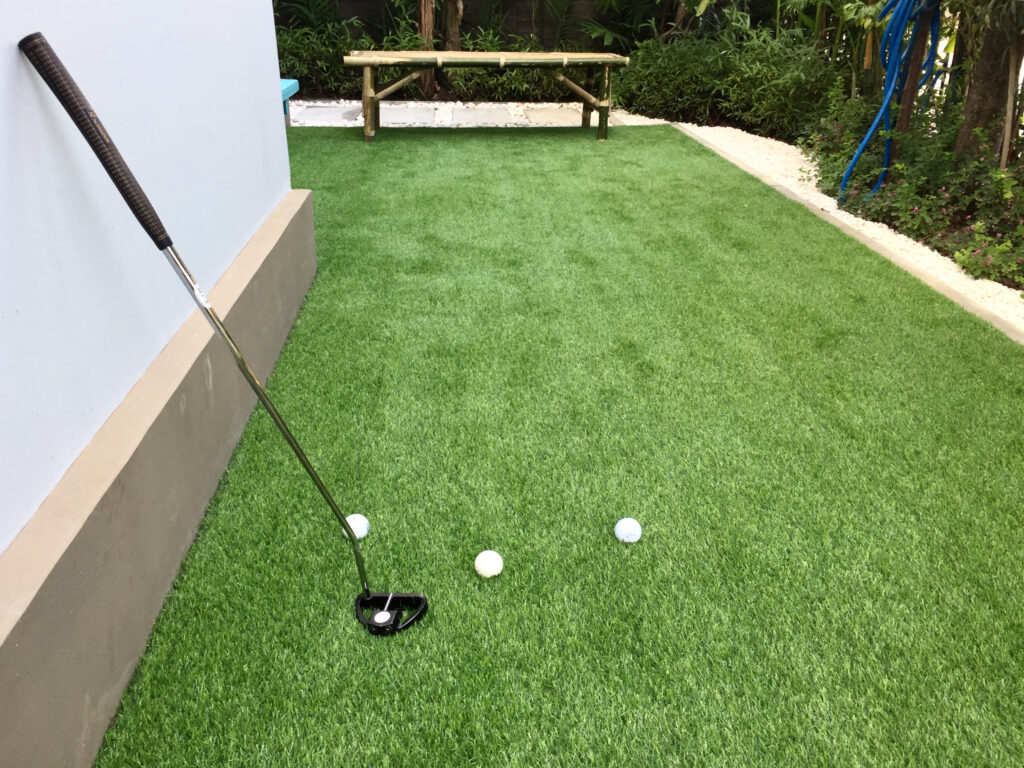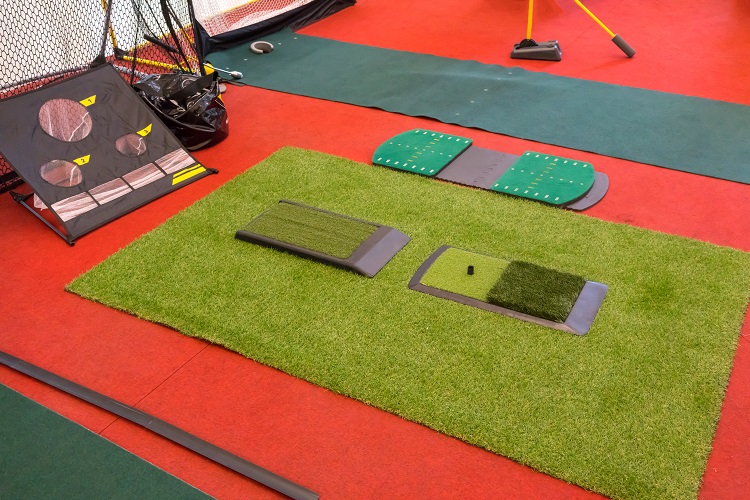As the winter months approach, building a practice setup at home to help build your game remains essential for the weekend warrior.
By taking months off, you can lose swing speed, lose rhythm in your tempo, and ultimately struggle to hit consistent golf shots once you return to the golf course.
For little money, amateur golfers can transform their garage or backyard into a playing haven that offers a place to take full swing practice.
Along the way, we’ll show you a few drills you can use to work on your swing and short game, creating good habits for the course.
Here’s how to practice golf at home.
Building the Right Setup

Before planning your setup, you need to consider the room you have at home. If you are fortunate enough to have a large backyard or large garage with high ceilings, then you are ahead of most golfers.
But for the sake of this discussion, let’s say you need to be creative.
Where should you begin?
Since there are three main areas of practicing golf you need to concentrate upon (full swing sessions, short game drills, and drills with the putter), it’s best to see if you can achieve all three with the space you have at home.
Unfortunately, weather or space may preclude you from swinging fully at home. If that’s the case, then you should make arrangements at an indoor facility to work on that area of your game.
The same may hold true for chipping.
In those instances, it’s wise to look for outdoor areas, such as a park, where you can work on chipping without damaging the ground or potentially placing people in danger with an errant ball.
Players can find fun ways to explore different avenues to work on tempo and distance control when it comes to using the putter at home.
Typically, this type of practice golf remains the easiest because you can do it anywhere.
Whether it be at home or in the office, putting a ball doesn’t really need much more than a smooth surface and some space to stretch out.
The Equipment You’ll Need

Alignment Sticks
One of the cheapest methods for working on your setup position comes with an alignment stick.
During drills on the practice golf range, these sticks have become wildly popular with coaches and PGA Tour golfers.
So it would be to your advantage if you know how to use alignment sticks.
Chipping Nets
A small, circular net allows golfers to work on their chipping in a small area.
By hitting balls from shorter distances into a chipping net, players can regulate their ball speed, launch angle, and distance when practicing their pitch and chip shots.
We rounded up the best golf nets for practicing at home.
Hitting Nets
If you have room for golf swing drills, then buying a hitting net that can withstand the blast offered by a driver or irons is an excellent option for at-home hitting sessions.
Most hitting nets can easily handle real golf balls as well.
The portability and lightweight nature of hitting nets make them ideal for at-home hitting setups because you can easily move the net to the best location for full shots.
Putting Mats
A putting mat offers a great way to work on your stroke during home practice golf.
Many of the drills when it comes to using the flatstick can work from the comfort of your favorite room in the house, especially with the best golf mat.
Finding a reliable indoor putting green can keep your putting stroke in shape as you work on building consistent, solid contact with your putter.
They come in various lengths to help you work on your distance control.
Foam Balls
Foam balls are great for working inside the home or apartment because they won’t break your valuables and do a reasonably solid job of simulating the feel of striking the golf ball.
With a sand wedge, you can efficiently work on your short game in a small area, learning how to spin the ball efficiently.
Developing a Routine

Set a Practice Schedule
When you practice golf at home, you always want to have an intention for your time.
Even if your purpose is to have fun and experiment with your workout, you can still build confidence and create shots that help your course management the next time you play golf.
And don’t forget mental practice during these at-home sessions. Building a pre-shot routine is crucial for golfers looking to improve their consistency.
Even if it’s just for five minutes per day, you can build a reliable routine that works when hitting any shot from your designated practicing area.
Full Swing Practice
When practicing golf during the colder months, you may need to improvise to work on your swing if you can’t hit golf balls at the driving range.
While there are several drills worth your time, here are two practice golf drills that don’t need golf balls to help you grow your golf game.
Pro Tip: Speed Control Drill
Here’s a great drill for working to build speed in the offseason.
First, take three alignment sticks and hold them together like a golf club. Then, take a natural golf swing, but on the downswing, stop the sticks as fast as you can at your waist.
If you are in balance on the downswing, your body will stay still at the point of stopping the sticks. But if you are out of balance, you’ll tip forward or lose footing.
Repeating this drill and stopping the sticks at the waist will build muscle memory, boost speed, and create the right club path so your balanced, powerful swing will be second nature when you hit the links.
Pro Tip: Backswing Drill
Another great drill for working on your shoulder turn away from the ball is to find the nearest wall.
This wall drill can be done with a club or without, depending upon the space you have in your house, although it is preferable to swing with a club.
For this simple drill, take the golf club, or even one of your alignment sticks, and take your natural address position with your backside touching the wall.
In this drill, we want to work on taking a full turn away from the ball without the club hitting the wall.
Since the initial move in the backswing concerns the shoulders, you shouldn’t hit the wall with the club. The same holds true on the downswing if you are correctly uncoiling your body.
If you can take swings without hitting the wall as you raise and lower the club, your iron play will improve dramatically.
Working on Your Short Game
When it comes to playing indoors, working on your short game offers the easiest way to improve. Here are a few drills that work your wedges and putter to help improve tempo and consistency.
Chipping
Pro Tip: Target Practice Drill
If you are stuck indoors, here’s a great and very enjoyable golf drill to hone your chipping. Take an indoor chipping net and place it far enough away where you can work on distance control.
Chipping with foam balls is a great way to simulate impact while seeing results, so if you can swing it, use these alternative balls for this drill.
On the chipping net, you should see holes along the entrance of the net. Take different clubs in your golf bag, set a number, and then count how many shots it takes to chip the foam balls into the designated hole.
Challenge yourself to lower the number each day, and you’ll develop better control over speed and height for your chips and pitch shots.
Putting
The great thing about using your putter indoors is that you can let your creativity show. You can putt on carpet or, if inclined, create an indoor oasis with mats and other materials to work on your stroke.
Pro Tip: Book Drill
Take two large books, such as dictionaries or even phone books, and place them slightly outside the width of your putter’s head.
By doing this, you are forcing your putter to stay straight in the backstroke as you move toward the ball.
If you don’t stay consistent, the books will move and you’ll receive instant feedback that you aren’t staying on the right path with your putting stroke.
Now, make attempts without the ball first. Once you get the hang of the movement, then use a ball.
If you take time every day to work on your stroke with this easy drill, you’ll find that your accuracy is off the charts once the weather becomes warmer.
Fitness and Mental Training for Improving Your Golf Skills at Home
Improving your golf game goes beyond the driving range or golf course. Fitness exercises and mental practice techniques can significantly enhance your performance, even from home.
Fitness Routines for Golfers
Building strength and flexibility is vital for a consistent swing. Incorporate exercises like lunges, planks, and rotational stretches to improve your core stability and hand-eye coordination.
Practicing golf grip and swing motion with light resistance bands can refine muscle memory.
If you have a golf net, use it to work on ball position and club selection, simulating real shots in a controlled environment.
Mental Practice Techniques
Mental toughness in golf starts with developing an adversity response.
Visualize different course scenarios and practice decision-making, such as choosing random targets for approach shots.
Watching professional golfers can also enhance your learning. Pay attention to their strategies, from ball position to club selection, and apply these insights during your own practice.
Watching Professional Golf as a Learning Tool
Professional golfers offer a masterclass in course management and mental composure.
Study their putting practice routines and how they approach tough situations. Combine these observations with your own putting drills, such as using a ball return method, to mimic pressure scenarios.
Integrating It All
By blending fitness exercises, mental practice, and studying professional golf, you can improve your skills at home.
Whether it’s hitting random targets into a golf net or practicing your grip, each small step prepares you to handle real-game challenges with confidence.
Frequently Asked Questions
How can I practice golf at home indoors?
Set up a golf net for full swings and work on ball position and hand-eye coordination.
Use a putting mat for putting practice with a ball return method. Practice your golf grip and simulate swings with lightweight clubs or resistance bands to improve strength and form.
How can I train for golf at home?
Combine fitness exercises like planks, squats, and rotational stretches to enhance flexibility and core strength. Practice random targets using a golf net and improve club selection skills.
Mental practice, such as visualizing adversity responses and studying course management, helps refine your game off the course.
How can I practice golf in my backyard?
Set up a golf net for full shots and random targets to simulate various course scenarios. Practice putting with a ball return method and work on your grip and ball position.
Incorporate drills for hand-eye coordination and test different clubs for improved performance under varied conditions.
What is the 20/20-20 rule in golf?
The 20/20-20 rule emphasizes breaking practice into 20-minute segments: 20 minutes on short game drills, 20 minutes on full swings, and 20 minutes of mental practice, like visualizing shots or reviewing professional golfers’ strategies.
This balanced approach optimizes skill development and builds mental focus.
How to Practice Golf at Home: Final Thoughts
The most important thing you can do when building your area for practice golf at home is to always look to have fun! If you aren’t enjoying your workout time, you are doing it wrong.
Before you even begin to plan, find a budget you are comfortable with and stay within those constraints.
99% of golfers can’t afford an at-home launch monitor or a dedicated room for hitting the golf ball, so don’t worry if you fall short when comparing yourself to the home setup of professional golfers.
Remember, you are working on your golf game to reach the goals you have set for yourself.
Whether you need more time on your short game or are looking to get that club more along the proper golf swing path on the downswing, an at-home practicing area can help you achieve that personal best score.
